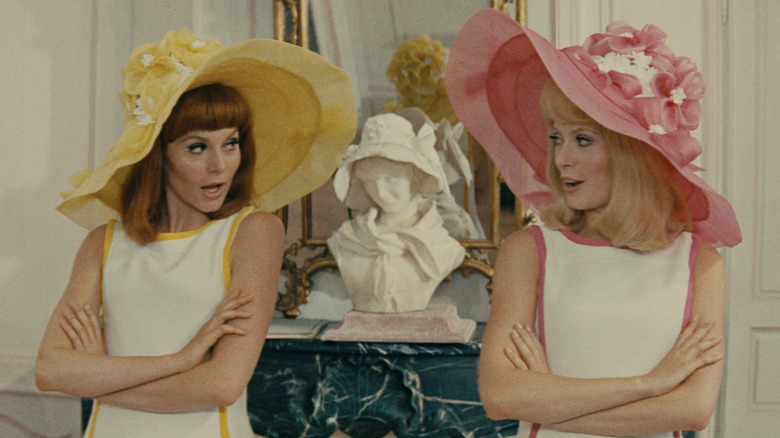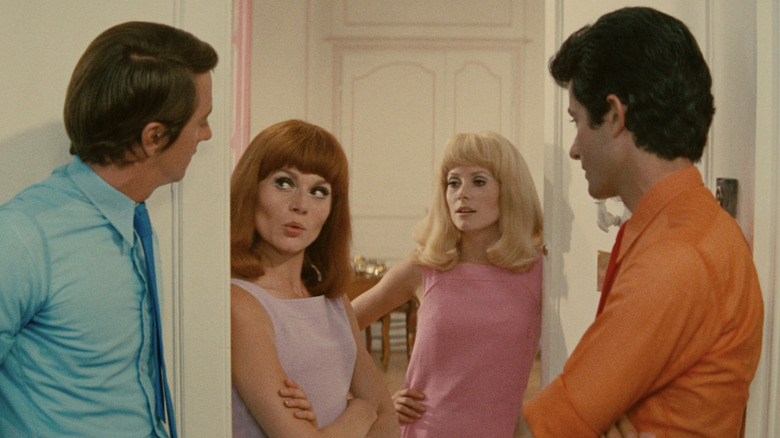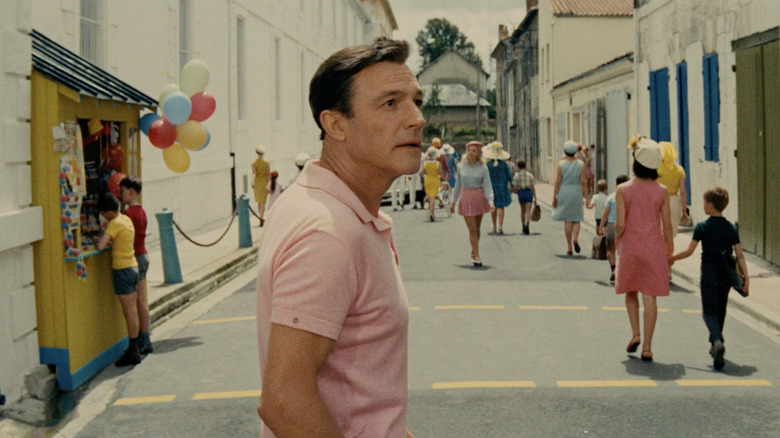The Daily Stream: The Young Girls Of Rochefort Creates An Unparalleled World Of Song And Dance
(Welcome to The Daily Stream, an ongoing series in which the /Film team shares what they've been watching, why it's worth checking out, and where you can stream it.)
The Movie: "The Young Girls of Rochefort" (1967)
Where You Can Stream It: HBO Max, Criterion Channel
The Pitch: Jacques Demy's vibrant portrait of the lovesick artists in a small French port town is one of the most effervescent movies you will ever see. "The Young Girls of Rochefort" builds upon Demy's previous movie musical, "The Umbrellas of Cherbourg," and creates a world made of music and romance, where every person gracefully dances down the street wearing eye-popping, boldly colored costumes. I dare you not to come out on the other side of this film without the biggest smile on your face and a new lease on life.
Why it's essential viewing
For my money, there is no greater pleasure than a perfectly executed movie musical. They don't happen often, but when they do, there is no high that matches the emotional and sensory overload they can incite. Musicals require dynamism to be effective. They challenge the filmmaker to build a world with the possibility of breaking into song and dance at any moment. It is not enough to just have a character stand in a room, singing about how they feel. While the tableau of that works on a stage, there's very little cinema to be found at that moment. In a truly visual medium like film, you theoretically could get the same information from the actor's face in close-up than through the song, and there's no need for a suspension of disbelief of any kind with that. A movie musical requires inventive staging and design to sell the imaginary circumstances of telling a story through song on film.
Jacques Demy may be the best to ever do it. "The Young Girls of Rochefort" is a masterclass in understanding exactly how to have your characters interact with their environment to create a heightened world of song. Even within a small apartment shared by twin sisters Delphine and Solange (real-life sisters Catherine Deneuve and Françoise Dorléac, respectively), Demy finds every conceivable angle to distinctly shoot several musical numbers without a single moment feeling cramped or hamstrung. His camera glides along with his performers. Shots transform from wide shots to close-ups and back to wides without cutting, while simultaneously circling around whose on-screen. A two-shot with Deneuve and Dorléac will not look like the same two-shot at the end of the shot as it did at the beginning. And if he needs to just take a step back and show some incredible dancing, he can do that, too.
Then there's the town of Rochefort, which he seemingly had free rein over. Every single person in this town of approximately 29,000 people exists in the same universe. People walk down the street, dressed in bright blues, yellows, and pinks, seemingly waiting for the music to start so they can join in on a number. One scene of Catherine Deneuve just walking to an art gallery consists of dozens of dancers performing jetés, kicks, and cartwheels down the street, even lifting Deneuve into the air at one point. This is not some big number, just an incidental walk, but it tells you everything you need to know about the world of "The Young Girls of Rochefort." While the location of Rochefort is a real place, the actual plane of existence it is on is a complete fantasy. Because of this heightened state, you can easily buy anything happening in the film without a chance of your suspension of disbelief being broken. All you have to do is witness and enjoy the magic.
Blending old and new school
Musicals are an exceptionally difficult art form to bring to the screen. Book musicals, that is. Sure, throughout Hollywood's golden age, they would crank out musicals like crazy, and a lot of them would be pure joys. Movie stars, from Fred Astaire to Judy Garland, would be made because of their work in musicals, and some of the greatest filmmakers of the era specialized in the form, including Vincente Minnelli and Stanley Donen. These movies, though, emerge from a time when a musical was something much different than it is today. Most musicals were light entertainments, where the actual stories being told were not being driven by the music. Instead, a story was constructed in order to get to the next song, which would inevitably be some toe-tapping spectacle or a ballad to showcase the singer's voice (typically the former, though).
The 1960s were a time of major change in how films were being made worldwide. Experimentation and pushing boundaries were now in vogue when they were once forbidden. You had France, Italy, the United States, and more breaking conventions and taboos. Out with the old, in with the new. One of the biggest casualties for film in the 1960s was the movie musical, which began the decade on the highs of "West Side Story" and "My Fair Lady" and came crashing down with "Dr. Dolittle" and "Hello, Dolly!" While many claim this was the death of the movie musical, it was actually a call for evolution. The desire for a bloated, frivolous musical was completely gone, but with it leaving, so did a lot of the instinctual know-how of shooting a musical number on film.
"The Young Girls of Rochefort" works as the perfect pivot point between the golden age of movie musicals and the desire for cinematic innovation. While the costuming and color scheme of the film echoes the Technicolor MGM musicals of the 1940s and '50s, placing everything in real locations instead of studio sets creates this wonderful bridge between reality and fantasy. It grounds this story of people falling in love at first sight into something you can both enjoy and actually invest in. And though it has the veneer of an old-style musical, every song here is firmly rooted in character and story. No matter how catchy Michel Legrand's melodies (and, boy, are the melodies catchy) or how splashy the choreography from Norman Maen are cannot take away that this is a true-blue book musical.
Bridging those worlds even more is the casting. Demy re-teaming with new it girl Catherine Deneuve, as well as her sister Françoise Dorléac (who sadly died in a car accident not too long after the film's release in France), shows a look to the future. Placing them in the same frames as "West Side Story" Oscar winner George Chakiris and, of course, Hollywood musical icon Gene Kelly (still dancing up a storm in his mid-50s) is a way to show how important those preceding films were at laying the groundwork that Jacques Demy could build upon. The two sides are part of the same continuum of a beautiful art form.
"The Umbrellas of Cherbourg" may be the Jacques Demy musical that gets all the headlines, but for me, "The Young Girls of Rochefort" is his masterpiece. This is everything you could hope to get out of a musical comedy on screen. Gorgeous dancing, terrific songs, beautiful design, charming characters, cinematic innovation. It truly transports you to another place for two hours that you never want to leave. All you have to do is fire up HBO Max or Criterion Channel to take a trip to Jacques Demy's ebullient Rochefort yourself.


